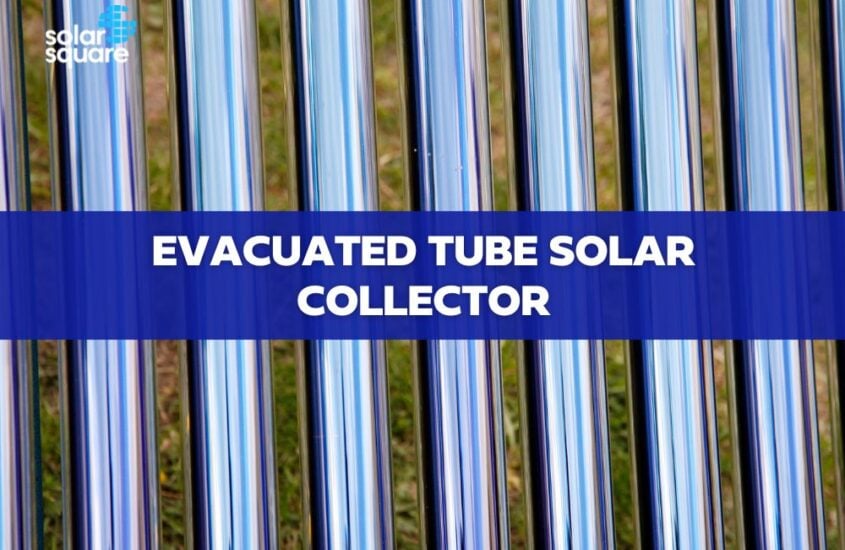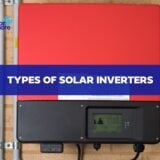Evacuated Tube Solar Collector: Types, Uses, Price, and More

How do you heat the water for your personal use? The answer will be either a geyser or an immersion rod. All these options require your active presence to avoid accidents.
But did you know you can utilise solar energy to heat the water? Yes! This is true.
The evacuated tube solar collector is an apparatus that traps the sun’s energy to heat water in the tube and supply it for various purposes. In addition, the extremely low temperature of the surroundings does not affect the high temperature inside the solar tubes.
So, if you install an evacuated tube solar collector on your rooftop, you don’t need to keep an eye on its functions and maintenance like conventional water heating systems.
What is an Evacuated Tube Solar Collector?
The evacuated tube solar collector is also known as a vacuum tube solar water heater. It consists of many parallel transparent glass tubes which are connected to the heater pipe.
These glass tubes are cylindrical in shape. So, they can trap the maximum heat from the sun and increase the temperature of the fluid in the pipe.
Now you must be wondering if the evacuated tube solar collector performs its functions when the sun rays are not intense. The answer is yes!
The cylindrical shape of the tubes receives the sun’s rays at a perpendicular angle. Therefore, even when the weather is cloudy, the evacuated tube solar collector efficiently performs its functions.
Components of Evacuated Tube Solar Collector
There are four major components in an evacuated tube solar collector that perform the function of heating water for utility. Let’s explore each of those components.
- Evacuated Tubes
They are made of low emissivity borosilicate glass, which has low iron content and high durability. Moreover, it employs an all-glass seal and AL selective coating, which facilitate the use of the solar energy spectrum for generating heat.
These tubes of an evacuated tube solar collector ensure high efficiency in bright and diffused sunlight.
- Copper Header
The copper header is excellent at transferring heat. It is corrosion-resistant and has a brazed connection. It uses a dry plug-in method of connection, which makes the installation and replacement convenient.
- Aluminium Manifold
The manifold has a powder-coated aluminium casing for increased longevity and structural integrity. In addition, the lightweight aluminium casing ensures convenient installation and reduces the roof load.
The glass wool insulation of the manifold and special UV stabilised silicon seal maintains the temperature of the tube.
- Heat Pipes
The evacuated tube solar collector has a U-shaped tube, which allows the free flow of the glycol solution. The heat pipes have a copper structure which ensures the heating of fluid at a low temperature of about 30 ⁰C.
The oxygen-free copper of the heat pipes has high purity, which is crucial for increased durability.
Types of Evacuated Tube Solar Collector
There are primarily two types of vacuum tube collectors. They are listed below:
- Direct-flow evacuated tube solar collector
It is also known as a U-pipe collector. It has two pipes inside the tube. One pipe is for the fluid inlet, and the other is for the outlet. The pipes are properly fixed because they allow the flow of fluid inside and outside the tube. Therefore, it is difficult to replace them.
It is generally believed that direct flow evacuated tubes are more energy efficient because there isn’t any heat exchange between the fluids. Moreover, this collector can trap diffuse and direct solar radiation without the requirement of solar tracking.
- Heat pipe evacuated tube solar collector
It has a copper heat pipe that attaches to an absorber plate inside a sealed solar tube. The heat pipe has a hollow and evacuated space, which contains liquids like alcohol or special additives.
The evacuated space allows heating of fluid at normal atmospheric pressure. As the sun rays hit the surface of the absorber, the liquid inside it starts boiling, and the hot vapour rises to the top of the pipe.
The fluid picks up the heat when it flows through the manifold. Afterward, the fluid in the heat pipe cools down and flows back to the tube. This process of heating and condensation keeps repeating till the sun shines.
Functions of an Evacuated Tube Solar Collector
If you are wondering how solar tube collectors function, continue reading to get the answer.
The evacuated tube collectors consist of one or multiple rows of parallel and transparent glass tubes fixed on a frame. Each tube has a different diameter and has a thick outer tube and a thin inner tube with a special coating to absorb solar heat.
A flat/curved copper or aluminium fin is placed inside the glass tube, which has a special coating to transfer the heat to the fluid through convection.
The copper pipe is also connected to the manifold, which in turn is attached to the water storage tank. Thus, the heating of the copper pipe results in the heating of the water in the tank.
In addition, the insulation of the vacuum tubes helps in maintaining the high temperature of the tube. Therefore, the water remains hot irrespective of the cold surrounding.
Conclusion
An Evacuated tube solar collector is an efficient way of heating water for personal and commercial purposes. Therefore, by installing this system, you can reduce the electricity consumption that goes into heating water.
However, you need an expert team for the installation purposes because it has a glass structure, which requires careful handling.
If you want to install your own evacuated tube solar collector, you must consider installing a pump system for proper circulation of fluid from the storage tank to the collector to prevent overheating.
FAQs
Q. How efficient are evacuated solar collectors?
Although evacuated solar collectors are expensive to install, they are highly efficient. Generally, they offer a conversion efficiency of 90 percent or above.
Q. Do evacuated tube solar collectors work in winter?
Yes, these collectors work in winter and any other day with solar radiation. However, their efficiency depends on the intensity of sun rays.
Q. How many solar collector tubes shall I install for domestic purposes?
According to the general rule, one flat panel is sufficient for a small house, whereas, for a large house, two flat panels are required.













